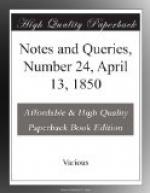Gilbert Browne.—“G.C.B.” is desirous of information respecting the family from which was descended Gilbert Browne of the Inner Temple, who died about a century ago, and was buried in North Mymms Church, Herts, where there is a monument to him (vide Clutterbuck’s History); also as to the arms, crest, and motto, as borne by him, and whether he was in any way related to Michael Browne of Hampton Court, Herefordshire, who married Elizabeth Philippa, daughter of Lord Coningsby, as stated in Collins’s Peerage. He also desires information as to any enrolment of arms previous to the Visitations, by which the bearings of families who had grants of land from the Conqueror may be ascertained; as, for instance, a family who began to decay about the end of the 14th century, having previously been of great rank and position.
The Badger.—Can any body point out to me any allusion, earlier than that in Sir T. Browne’s Vulgar Errors, to the popular idea that the legs of the badger were shorter on one side than on the other, whence Mr. Macaulay says, “I think that Titus Oates was as uneven as a badger?”
W.R.F.
Ecclesiastical Year.—Note in an old parish register, A.D. 1706. “Annus Domini Secundum Ecclesiae Anglicanae Supputationem incipit 25to Mensis Martij.”
Query the authority for this? the reason seems easy to define.
NATHAN.
Sir William Coventry.—Pepys mentions in his Diary, that Sir William Conventry kept a journal of public events. Is anything known of this journal? It is not known of at Longleat, where are several papers of Sir William Conventry’s.
A MS. letter from Lord Weymouth to Sir Robert Southwell, giving an account of Sir W. Conventry’s death, was sold at the sale of Lord de Clifford’s papers in 1834. Can any of your readers inform me where this letter now is?
C.
Shrew.—Is shrew, as applied to the shrew-mouse, and as applied to a scolding woman, the same word? If so, what is its derivation?
The following derivations of the word are cited by Mr. Bell. Saxon, “Schreadan,” to cut; “Schrif,” to censure; “Scheorfian,” to bite; “Schyrvan,” to beguile. German, “Schreiven,” to clamour; none of which, it is obvious, come very near to “Schreava,” the undoubted Saxon origin of the word shrew.
Now it was a custom amongst our forefathers to endeavour to provide a remedy against the baneful influence of the shrew-mouse by plugging the wretched animal alive in a hole made in the body of an ash tree, any branch of which was thenceforth held to be possessed of a power to cure the disease caused by the mouse. It thereupon occurred to me that just as brock, a still existing name for the badger, is clearly from the Saxon broc, persecution, in allusion to the custom of baiting the animal; so schreava




